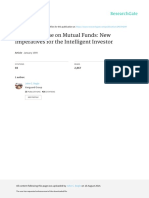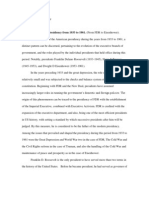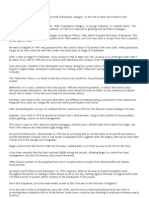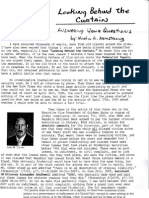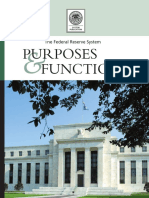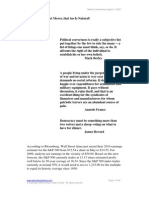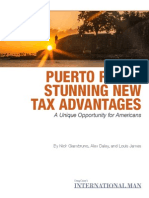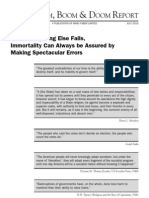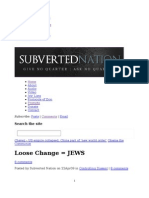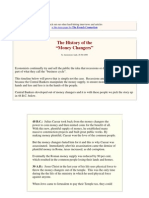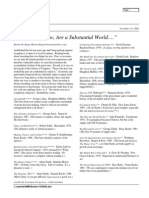0 ratings0% found this document useful (0 votes)
69 viewsAnything Bat
Anything Bat
Uploaded by
api-237654943Copyright:
Attribution Non-Commercial (BY-NC)
Available Formats
Download as PPTX, PDF, TXT or read online from Scribd
Anything Bat
Anything Bat
Uploaded by
api-2376549430 ratings0% found this document useful (0 votes)
69 views21 pagesOriginal Title
anything bat
Copyright
© Attribution Non-Commercial (BY-NC)
Available Formats
PPTX, PDF, TXT or read online from Scribd
Share this document
Did you find this document useful?
Is this content inappropriate?
Copyright:
Attribution Non-Commercial (BY-NC)
Available Formats
Download as PPTX, PDF, TXT or read online from Scribd
Download as pptx, pdf, or txt
0 ratings0% found this document useful (0 votes)
69 views21 pagesAnything Bat
Anything Bat
Uploaded by
api-237654943Copyright:
Attribution Non-Commercial (BY-NC)
Available Formats
Download as PPTX, PDF, TXT or read online from Scribd
Download as pptx, pdf, or txt
You are on page 1of 21
FED Timeline
by: Paul Lopez & Jonathan Cordero
http://www.federalreserveeducation.org/about-the-fed/history/
1775-1791: U.S. Currency
* During the American Revolution, Congress came out with the first paper
money known as Continentals.
* They exceeded the amount of currency circulating, causing inflation. * In the end. the were considered worthless.
1791-1836: First Attempt at Central Banking
Alexander Hamilton was trying to start a Central Bank and it was called the First Bank of the United States in 1791. It was located in Philadelphia It was the largest corporation in the country It was funded by big banking and money interests
People were not sure in having one big bank.
20 years after it was established, its charter ran out and it was renewed in 1811
1816-1836: A Second Try Fails
* 1816- Congress made the Second Bank of the United States. * 1828- Andrew Jackson was elected president. * Jackson wanted to get rid of the bank. * 1836- Banks charter expired (never renewed.)
1836-1865: The Free Banking Era
State-chartered and unchartered free banks began Each bank started to issue their own money, backed by gold They offered demand deposits to enhance commerce
Because of too many check transactions, the New York Clearinghouse Association was started
The Association helped, in 1853, to give people a way to exchange checks and control accounts
1863: National Banking Act
* 1863- National Banking Act was passed. * Circulating notes were backed by U.S. government securities to the nationally chartered banks * Uniform Currency for U.S.
1873-1907: Financial Panics Prevail
The nations economy is plagued with bank runs and financial panics In 1893, there was a banking panic that started the worst depression in the United States J.P. Morgan stabilized the economy
1907: A Very Bad Year
* 1907- Wall Street Panic * People started thinking we need a more secure banking system. * Central banking authority needed to ensure healthy banking system and provide elastic currency.
1908-1912: The Stage is Set for Decentralized Central Bank
The Aldrich-Vreeland Act of 1908 was passed because of the panic of 1907 It made the emergency relief fund It established the National Monetary Commission Nelson Aldridge developed a bankercontrolled plan Progressives attacked this plan extensively Woodrow Wilson stopped the plan
1912: Woodrow Wilson as Financial Reformer
Woodrow Wilson, although not knowing much about financial issues, gave expert advice to Carter Glass, which allowed him to be Chairman of the House on Banking and Finance The committee had an adviser called H. Parker Willis, which helped Wilson develop the Federal Reserve act
1913: The Federal Reserve System is Born
From December 1912 to December 1913, the Glass-Willis proposal was debated and edited heavily In December 23, 1913 Woodrow Wilson signed the Federal Reserve Act This was a compromise for a decentralized central bank that took care of checks and balances
1914: Open for Business
The Reserve Bank Operating Committee had to make working banks that were based on the new laws In November 16, 1914, 12 cities were chosen to have reserve banks Soon after, World War I broke out in Europe
1914-1919: Fed Policy During War
During World War I, banks continued regular function because of the Aldrich-Vreeland act The biggest impact at this time was the Federal Reserve banks being able to discount bankers acceptance.
1920s: The Beginning of Open Market Operations
After World War I, Benjamin Strong, the head of the Fed in New York in 1914, realized that gold cannot be used as the central factor of controlling credit Strong wanted to change to a paper standard which would make a recession but it would allow a large purchase of government securities and it shows how strong open market operations are
1929-1933: The Market Crash and the Great Depression
in 1920, Carter Glass, a Virginia representative warned people about the stock market crash In October, 1929, the stock market crashed and the United States was in the Great Depression From 1930-1933, about 10,000 banks were bankrupt In March 1933, the president had to do a bank holiday to help banks to rebuild
1933: The Depression Aftermath
After the Great Depression, Congress passed the Glass-Steagall act in 1933, which comprised of the separation of commercial and investment banking and making people use government securities as Federal Reserve Note replacements The Glass-Steagall act also started the Federal Deposit Insurance Corporation or the FDIC
1935: More Changes to Come
The Banking act in 1935 made the Federal Reserve change its structure These changes made the Federal Open Market Committee, which is a separate legal entity from the Fed, and the Treasury secretary and the comptroller of currency were removed from the feds board The Employment act was passed after World War II
1951: The Treasury Accord
The Fed committed to having a low interest rate peg on government bonds after the United States entered World War II This was supported by President Harry Truman and Secretary of the Treasury John Snyder The goal at this time of the Federal Reserve is to settle interest rates and monetary policy with the Treasury
1970s-1980s: Inflation and Deflation
In the 1970s, inflation started making consumer prices, producer prices, and oil prices rise When Paul Volcker was the head of the Fed, inflation was ended
1980: Setting the Stage for Financial Modernization
The Monetary Control Act of 1980 made the Fed price their financial services competitively In 1999, the Gramm-Leach-Biley Act overrode the Glass Steagall act of 1933
1990s: The Longest Economic Expansion
The Stock Market Crashed on October 19, 1987 which made the Fed issue a statement before October 20 There was a 10 year period of economic expansion which was halted because of a small recession from March to November 2001 The Fed lowered interest rates rapidly in the early 1990s
September 11, 2001
The Fed was put to a test when terrorists attack the World Trade Center The fed was forced to make another statement, lower interest rates, and loan out more than $45 billion to financial institutions After September, the Fed lending had lowered to about before September 11
January 2003: Discount Window Operation Changes
In 2003, The Fed changes its discount window operations
2006 and Beyond: Financial Crisis and Response
In the early 2000s low mortgage rates and expanded access to credit lead to a housing boom This boom lead to the mortgages to be bundled and traded
You might also like
- National Debt Crisis Instructor Directions PDFDocument1 pageNational Debt Crisis Instructor Directions PDFScott MartzNo ratings yet
- The Long Term by Howard S. KatzDocument4 pagesThe Long Term by Howard S. Katzapi-22433340No ratings yet
- Joseph E. Granville, ObituaryDocument4 pagesJoseph E. Granville, ObituaryObituaries_GNo ratings yet
- Road To The Revolution TestDocument4 pagesRoad To The Revolution Testapi-292434666No ratings yet
- Common Sense On Mutual Funds New Imperatives For TDocument3 pagesCommon Sense On Mutual Funds New Imperatives For Tau nishNo ratings yet
- The American Presidency From 1933 To 1961Document12 pagesThe American Presidency From 1933 To 1961Roosevelt AkumeNo ratings yet
- Acquisition Assignment IGate-PatniDocument17 pagesAcquisition Assignment IGate-PatniRanjitNo ratings yet
- Capital Accumalation and Wealth Building Index - PHPDocument278 pagesCapital Accumalation and Wealth Building Index - PHPGeorge Bailey50% (2)
- How The Federal Reserve Implements Monetary PolicyDocument37 pagesHow The Federal Reserve Implements Monetary Policybüşra çakmakNo ratings yet
- The Federalist PeriodDocument39 pagesThe Federalist Periodapi-328120679No ratings yet
- Unit 7 Central Banking - ESP Int'l Banking and FinanceDocument27 pagesUnit 7 Central Banking - ESP Int'l Banking and FinanceUyên PhươngNo ratings yet
- Imf & SDRDocument48 pagesImf & SDRAprajita SharmaNo ratings yet
- Debt, Credit and Finance Capital by Plotkin and ScheuermanDocument8 pagesDebt, Credit and Finance Capital by Plotkin and Scheuermandennis ridenourNo ratings yet
- Contribution Adam SmithDocument33 pagesContribution Adam SmithLohith N ReddyNo ratings yet
- The Clash of The Cabinet: USHC 1.6Document25 pagesThe Clash of The Cabinet: USHC 1.6yomomslilybuums100% (1)
- George SorosDocument2 pagesGeorge Soroshttp://besthedgefund.blogspot.comNo ratings yet
- XRP and StellarDocument2 pagesXRP and Stellarong0625No ratings yet
- Eclectica 08-09Document4 pagesEclectica 08-09ArcturusCapitalNo ratings yet
- Permanence: 17th June 2013Document5 pagesPermanence: 17th June 2013tony caputi100% (1)
- Major Banks, Governmental Officials and Their Comrade Capitalists Targets of Spire Law Group, LLP's Racketeering and Money Laundering Lawsuit Seeking Return of $43 Trillion to the United States Treasury - MarketWatchDocument5 pagesMajor Banks, Governmental Officials and Their Comrade Capitalists Targets of Spire Law Group, LLP's Racketeering and Money Laundering Lawsuit Seeking Return of $43 Trillion to the United States Treasury - MarketWatchPeter T. SantilliNo ratings yet
- Answers To Questions Behind The CurtainDocument5 pagesAnswers To Questions Behind The CurtainKris100% (13)
- Part 3 Neoclassical Economic Thought and Its CriticsDocument35 pagesPart 3 Neoclassical Economic Thought and Its CriticsFe MagbooNo ratings yet
- Faber ReportDocument43 pagesFaber ReportgrneNo ratings yet
- The Pseudoscience of EconomicsDocument30 pagesThe Pseudoscience of EconomicsPeter LapsanskyNo ratings yet
- Rules For RadicalsDocument2 pagesRules For RadicalsMce Reg100% (1)
- Money and BankingDocument66 pagesMoney and BankingNasrudin Mohamed AhmedNo ratings yet
- Federal Reserve - Purposes and Functions (2005)Document146 pagesFederal Reserve - Purposes and Functions (2005)Ragnar DanneskjoldNo ratings yet
- The Creature From Jekyll IslandDocument22 pagesThe Creature From Jekyll IslandTajda KrajncNo ratings yet
- PPTDocument21 pagesPPTRazan TataiNo ratings yet
- Behind The Curtain - The Full Monty (Part One)Document24 pagesBehind The Curtain - The Full Monty (Part One)Kris83% (6)
- mentary.2009.08.RETAiL - Ebook sUppLeXDocument20 pagesmentary.2009.08.RETAiL - Ebook sUppLeXsidjain89No ratings yet
- Evolution of Money and BankingDocument17 pagesEvolution of Money and BankingUmar HayatNo ratings yet
- BrittonDocument26 pagesBrittonNidhin NalinamNo ratings yet
- Fed Tools For Controlling The Money Supply: Open Market OperationsDocument6 pagesFed Tools For Controlling The Money Supply: Open Market OperationsPOOJA GUPTANo ratings yet
- Puerto Rico SRDocument50 pagesPuerto Rico SREdmund Sullivan100% (1)
- Pujo Committee 2Document3 pagesPujo Committee 2Keith KnightNo ratings yet
- Marc Fabers The Gloom Boom Doom ReportDocument20 pagesMarc Fabers The Gloom Boom Doom ReportMikle196950% (2)
- Chapter Six: Bond MarketsDocument39 pagesChapter Six: Bond MarketsYash PiyushNo ratings yet
- February 17, 1913Document6 pagesFebruary 17, 1913Collier Meyerson100% (1)
- Loose Change JEWS: Murder & GenocideDocument4 pagesLoose Change JEWS: Murder & Genocidefarhan0% (1)
- Capitalism A Love StoryDocument7 pagesCapitalism A Love StorytheurgliestNo ratings yet
- Early Republic - WashingtonDocument12 pagesEarly Republic - Washingtonapi-305127889No ratings yet
- Banking TimeLineDocument58 pagesBanking TimeLineNarita MinoruNo ratings yet
- The Production of Money - Ann Pettifor's LSE LectureDocument20 pagesThe Production of Money - Ann Pettifor's LSE Lectureemontesa100% (1)
- 7 Principles of GovernmentDocument8 pages7 Principles of GovernmentMaria Jesusa MananonNo ratings yet
- Barton Biggs Reading ListDocument2 pagesBarton Biggs Reading Listwarren_10No ratings yet
- Workers Vanguard No 439 - 30 October 1987Document16 pagesWorkers Vanguard No 439 - 30 October 1987Workers VanguardNo ratings yet
- Congressman McFadden On The Federal Reserve Corporation Remarks in Congress 1934Document36 pagesCongressman McFadden On The Federal Reserve Corporation Remarks in Congress 1934Abda YasharahlaNo ratings yet
- Selling America Short: The SEC and Market Contrarians in the Age of AbsurdityFrom EverandSelling America Short: The SEC and Market Contrarians in the Age of AbsurdityRating: 5 out of 5 stars5/5 (1)
- What Became of the Crow?: The inside story of the greatest gold discovery in historyFrom EverandWhat Became of the Crow?: The inside story of the greatest gold discovery in historyNo ratings yet
- You Know I'm Right: More Prosperity, Less GovernmentFrom EverandYou Know I'm Right: More Prosperity, Less GovernmentNo ratings yet
- The New Future of Money: How Our Debt Money System is Wrecking the World And How You Can Change ItFrom EverandThe New Future of Money: How Our Debt Money System is Wrecking the World And How You Can Change ItRating: 5 out of 5 stars5/5 (1)
- Crowdfunding in 2014 (Understanding a New Asset Class)From EverandCrowdfunding in 2014 (Understanding a New Asset Class)No ratings yet
- Global Shocks: An Investment Guide for Turbulent MarketsFrom EverandGlobal Shocks: An Investment Guide for Turbulent MarketsNo ratings yet
- Lesson 1 - Time of DayDocument16 pagesLesson 1 - Time of Daymankirmohammed92No ratings yet
- Indian Stamp Act by B.A.P.S.Document32 pagesIndian Stamp Act by B.A.P.S.B.A.PrabushankarNo ratings yet
- Akt PT Buana Jurnal KhususDocument24 pagesAkt PT Buana Jurnal KhususAdinda Dwi AriyantiNo ratings yet
- Annexure 3 Compensation FeeDocument3 pagesAnnexure 3 Compensation FeeTech TipsNo ratings yet
- 1500 Claim FormDocument2 pages1500 Claim Formrashid aliNo ratings yet
- ICAEW - Accounting 2020 - Chap 5Document51 pagesICAEW - Accounting 2020 - Chap 5TRIEN DINH TIENNo ratings yet
- Advanced Candlestick Pattern 2.0Document12 pagesAdvanced Candlestick Pattern 2.0Kamal Reddy0% (1)
- AlgoTradeSoft V9.78Document2 pagesAlgoTradeSoft V9.78yabNo ratings yet
- PayslipDocument1 pagePayslipchloeNo ratings yet
- DSEX Market PriceDocument93 pagesDSEX Market PriceMd. Hasibul HuqNo ratings yet
- BEFA Unit - 1Document22 pagesBEFA Unit - 1sheelamakshay042No ratings yet
- 2010 Guarante Export NordeaDocument2 pages2010 Guarante Export NordeaAtthippattu Srinivasan MuralitharanNo ratings yet
- Equity Risk Premium - Damodaran PDFDocument95 pagesEquity Risk Premium - Damodaran PDFNazar TymtsiasNo ratings yet
- Group 7 Excel FunctionDocument7 pagesGroup 7 Excel FunctionJudy Ann BenongNo ratings yet
- CV - Rangga GanesatriaDocument7 pagesCV - Rangga GanesatriaAnkit LalwaniNo ratings yet
- A PROJECT On Integrated Marketing CommunicationDocument21 pagesA PROJECT On Integrated Marketing CommunicationMahargha BarmanNo ratings yet
- Form 60 - May, 2021Document19 pagesForm 60 - May, 2021Hannah ManieboNo ratings yet
- CBSE Woksheets For Class 12 Entrepreneurship Chapter 5 Business Arithmetic PDFDocument2 pagesCBSE Woksheets For Class 12 Entrepreneurship Chapter 5 Business Arithmetic PDFAbheejit VijayNo ratings yet
- Assessment Task 3 - BAFI3192Document9 pagesAssessment Task 3 - BAFI3192trantonnhu04102000No ratings yet
- Quantitative FinanceDocument3 pagesQuantitative FinanceaishNo ratings yet
- Updated CV - Ruchira PereraDocument5 pagesUpdated CV - Ruchira Pereraayaz akhtarNo ratings yet
- Assignment 2, Managing Personal FinanceDocument3 pagesAssignment 2, Managing Personal FinancekckotigalaNo ratings yet
- Bank Management SystemDocument5 pagesBank Management SystemMohd ShahramNo ratings yet
- How To Create Bank Statement Transaction Creation Rules and Account Bank Charges Fees or InterestDocument9 pagesHow To Create Bank Statement Transaction Creation Rules and Account Bank Charges Fees or Interestmanpreetgil100% (1)
- Master Budget KB MaterialDocument40 pagesMaster Budget KB MaterialNigus AyeleNo ratings yet
- SCH 3 Div 3Document219 pagesSCH 3 Div 3Shri Krishna BhatiNo ratings yet
- Carlingford - March EP Update - Part 1 - Premier OilDocument14 pagesCarlingford - March EP Update - Part 1 - Premier Oil55entiNo ratings yet
- One Credit Card Statement (20 Sep 2024 - 19 Oct 2024) : Rahul SehrawatDocument7 pagesOne Credit Card Statement (20 Sep 2024 - 19 Oct 2024) : Rahul Sehrawatopmishra69420No ratings yet
- Siam CityDocument16 pagesSiam CityAstrid BuenacosaNo ratings yet




